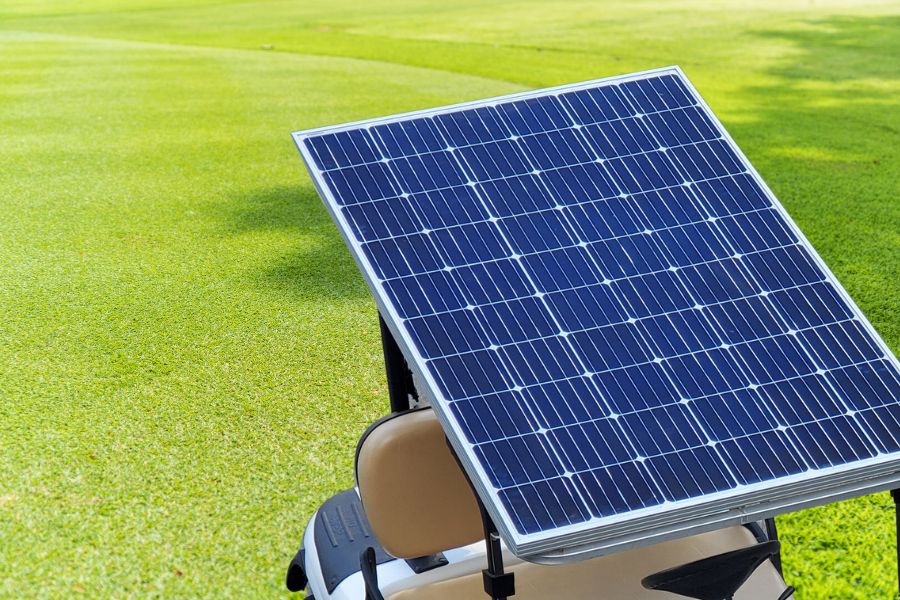-
Shopping Tools
-
Care & Maintenance
-
About
-
Dealer Login

Solar-powered golf carts use solar panels to capture sunlight and convert it into electricity, which is stored in batteries to power the cart's electric motor and extend its range. This eco-friendly solution reduces the need for conventional charging and provides a sustainable alternative for golf courses and recreational use.
Solar-powered golf carts operate by utilizing photovoltaic (PV) panels installed on the roof of the cart. These panels harness sunlight, which is then converted into usable electricity. This process helps keep the cart running while reducing the reliance on traditional charging methods. Let’s break down how it all happens:
The solar panels, typically mounted on the roof or canopy of the golf cart, absorb sunlight. These panels are made up of solar cells that capture the sun's energy, even on cloudy days, though the efficiency is higher when the sun is at its peak. The number of panels and their efficiency will affect how much sunlight can be converted into electricity.
The photovoltaic cells in the solar panels convert the absorbed sunlight into direct current (DC) electricity. This process is called the photovoltaic effect, where sunlight strikes the panels, causing electrons to move and generate electricity. The power generated is then directed to the next phase of the system.
Once the electricity is generated, it flows through a solar charge controller. This device is essential for regulating the voltage and current coming from the solar panels, ensuring that the power being sent to the batteries is steady and safe. The controller prevents overcharging, which can damage the batteries and reduce their lifespan. It also ensures that the batteries are charged optimally, even when sunlight levels fluctuate throughout the day.
The regulated power is stored in the golf cart's battery system. These batteries can be either lead-acid or lithium-ion, depending on the golf cart model. Solar charging helps maintain the battery's charge without having to rely entirely on external charging stations, extending the cart's range over time. The batteries store the energy for later use, allowing the cart to operate even when the sun isn’t shining.
When the golf cart is in use, the stored energy in the batteries is released to power the electric motor. The electric motor then drives the wheels of the cart, propelling it forward. This process is similar to how any electric golf cart operates, except that solar energy is being used to replenish the batteries. The efficiency of the solar panels determines how much energy can be harvested, which in turn influences the golf cart’s overall range and performance.
One of the main benefits of solar-powered golf carts is the extended range. The solar panels continuously charge the batteries while the cart is in use (or parked in the sun), reducing the need for frequent plug-in charging. This makes solar-powered carts particularly useful on golf courses and large properties, where the cart may be used for long stretches of time without access to traditional charging stations.
Using solar power can significantly reduce operating costs over time. While the initial installation of solar panels can be an investment, it can save money in the long run by reducing electricity consumption. Since sunlight is free, the golf cart owner or facility doesn’t have to worry about rising electricity costs associated with traditional charging methods. Over time, this leads to savings on utility bills and fewer charging station setups.
Solar-powered golf carts are environmentally friendly. By harnessing the sun's energy, they produce zero emissions and reduce the carbon footprint associated with gasoline-powered carts or electric carts charged from fossil fuel-based sources. Golf courses, resorts, and recreational facilities can benefit from adopting solar-powered carts as part of their sustainability efforts, helping to promote a greener environment.
Solar charging can also help enhance the lifespan of the golf cart’s batteries. By maintaining a steady, gradual charge, solar energy prevents deep discharges and overcharges, which are common issues with traditional chargers. This gentle charging process can prolong the battery’s overall lifespan, leading to fewer replacements and reduced maintenance costs over time.
Installing a solar panel on a golf cart is a relatively straightforward process that can be done with some basic tools and knowledge. Here’s a step-by-step guide:
Charging a golf cart with solar power is simple once the system is set up. Here’s how to do it:
Solar-powered golf carts provide an efficient and environmentally friendly solution for electric cart owners. By converting sunlight into usable electricity, solar panels help extend the cart's range, reduce operating costs, and contribute to a greener environment. While installing a solar panel may require an initial investment, the long-term benefits make it an excellent choice for those looking to reduce their reliance on traditional charging methods.
